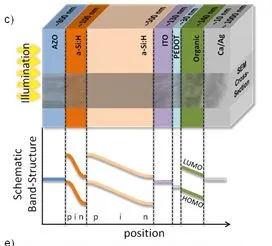Maximum efficiency, minimum materials and complexity
Silicon-based thin-film solar cell with a supplementary organic layer can utilise infrared light as well
The cell consists of many active layers, which taken together are less than one micron thick. The new hybrid solar cell is constructed of two extremely thin layers of amorphous silicon as well as an organic layer. Despite the low volume of materials employed, the hybrid cell attains recording-breaking efficiency of 11.7%. The organic layer is made of fullerenes, also known as “soccer ball molecules”, mixed with semiconducting polymers. It is able to convert infrared light that cannot be utilised by the silicon layers into electrical energy.
The complementary compound of organic and inorganic materials in a stacked cell offers a promising option for future solar cells. The cell was jointly developed through the BMBF “Leading-edge Research and Innovation in the New German Länder” programme by teams at the University of Potsdam and HZB who have published their work in the renowned technical journal Advanced Materials.
The fundamental component of the cell is a very thin layer of amorphous silicon interspersed with hydrogen (hydrogenated amorphous silicon / a-Si:H). These kinds of simple thin-film solar cells do not attain high efficiencies, as they can only use photons in the blue and green regions of the spectrum.
Steffen Roland, a doctoral student in Prof. Dieter Neher’s group at the University of Potsdam, and Sebastian Neubert, a doctoral student under Prof. Rutger Schlatmann in PVcomB at HZB, added first another a-Si:H layer to a tandem cell and then deposited an additional organic layer that enables infrared light as well to be converted into electrical energy. In this manner, they were able to increase the efficiency of the triple-junction cell to over 11%. At the same time, the structure of this solar cell is able to withstand the effects of aging better. This success impressively demonstrates how the close cooperation of doctoral students from different fields of study (organic semiconductors and inorganic semiconductors) leads to new device structures with improved properties.
“The cell can be fabricated easily with established thin-film technology common in the industry, and is also suited to production in large sheets”, explains Schlatmann. Neher adds: “The high absorption coefficients of a-SI:H layers and the properties of the organic layer make possible an active stack no thicker than one micron - that is maximum efficiency with minimum materials!”
Article first published online 7 January 2015 in Advanced Materials: Hybrid Organic/Inorganic Thin-Film Multijunction Solar Cells Exceeding 11% Power Conversion Efficiency
DOI: 10.1002/adma.201404698
Further Information:
Prof. Dr. Rutger Schlatmann
Institute Competence Centre Photovoltaics Berlin (PVcomB)
Helmholtz-Zentrum Berlin für Materialien und Energie
Tel.: (030) 8062-15680
Fax: (030) 8062-15677
Email: rutger.schlatmann(at)helmholtz-berlin.de
Press Office:
Dr. Antonia Rötger
Helmholtz-Zentrum Berlin für Materialien und Energie
Tel.: (030) 8062-43733
Fax: (030) 8062-42998
Email: antonia.roetger(at)helmholtz-berlin.de
Research partner University Potsdam
Prof. Dr. Dieter Neher
Tel.: 0331 977 1265
Email: neher(at)uni-potsdam.de
